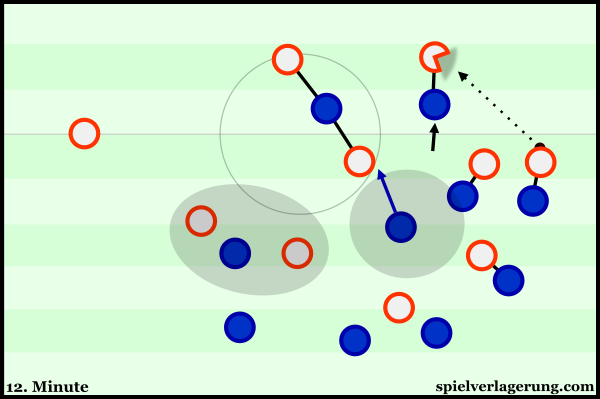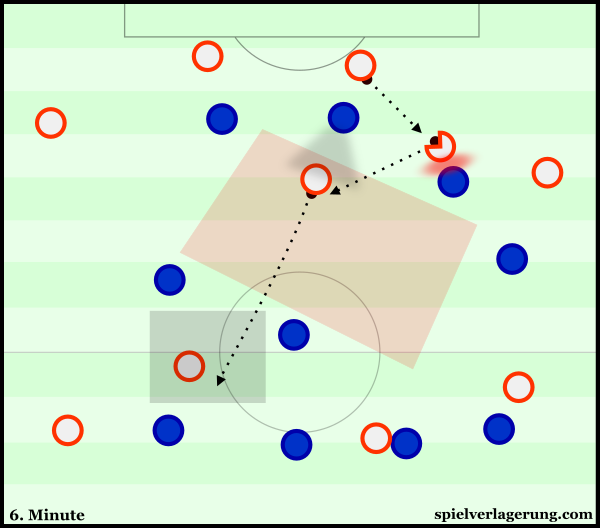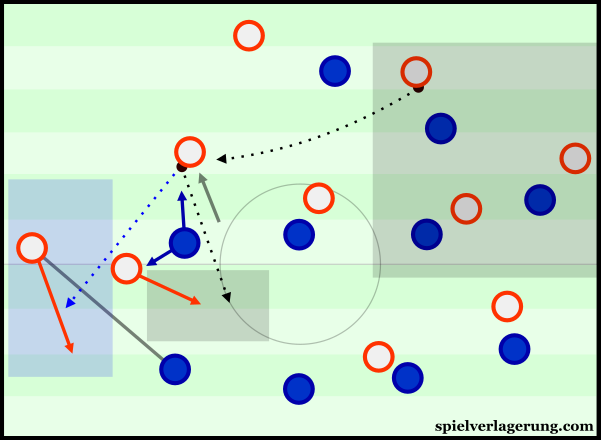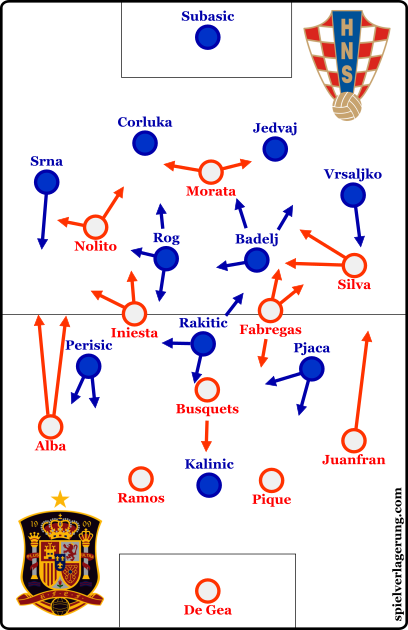Croatia’s counter-attacking game brings late win over Spain
Although the grace of Luka Modric was not to be pitted against that of Busquets and Iniesta, we were still given one of the better games of EURO2016 in one of the first matches between two competent sides.
Early Croatian pressing
Croatia made their intentions know early in the game and showed promise in doing so as they pressed high into Spain’s build-up of possession. Kalinic was supported closely by the moving-up Rakitic as Croatia used clear man-orientations as their means of maintain close positions to the deeper Spain players. Defending between said 4-4-2 and a 4-4-1-1, their shape roughly matched that of Spain thus allowing them to more easily match-up man-to-man as Rakitic followed Busquets whilst the two central midfielders covered Fabregas and Iniesta in deeper positions.

A scene in which Croatia created 1v1 challenges through man-orientations. They were able to regain the ball for a potentially dangerous 2v2 against the centre-backs.
Through these man-orientations, Croatia were able to force a number of one-on-one battles which were the source of their threat in the early chances. On a couple of occasions they were able to force turnovers in dangerous areas through challenges against the Spanish back-line and goalkeeper. Just before Rakitic’s lobbed chance in the 13th minute, a press of Kalinic, Rakitic and Perisic worked to close down the ball back to De Gea and then cover any of his immediate options, giving them time to reach the goalkeeper and challenge his clearance.
Against a side such as Spain, it’s clear that they wanted to challenge their opposition’s build-up phase and restrict them from making clean progressions through the first and second lines. As Spanish national Juanmo Lillo states, the first progression is crucial in making everything which comes after it cleaner. The man-orientations acted as a means of access as well as a way for Croatia to directly challenge Spain’s construction game as they tried to disrupt it the best they could.
With the lesser side of possession and a more limited attacking game, it’s no doubt that their pressing was intended as an offensive tool too. These man-orientations were used to enforce the direct challenges which could lead to the turnovers which were seen throughout the game.
Despite their early threats however, it was ineffective pressing which lead to Croatia’s early set-back when Alvaro Morata converted one of the easier goals he’ll make. The defending team looked to once again engage Spain’s possession early in its conception, yet did so with extremely weak and inappropriate spacing with minimal spatial compactness.
Rakitic joined Kalinic in the first line again whilst Rog moved up in order to create access on Iniesta who was positioned deep within his half-space. Behind these three however there was a significant vat of space available as Badelj was far too deep within the defensive block.
Iniesta timed his action perfectly to allow a wall pass from Ramos in order to bypass Kalinic’s cover shadow to play the ball into Sergio Busquets who now profited from acres of space. You might not have thought it, but this situation didn’t turn out well for Croatia’s defence. Busquets had all the time to make an excellent ball to Fabregas whose deflected pass then found David Silva.
Silva did what he does best and played an incisive reverse pass back towards the run of Fabregas whose wide shot was converted by Alvaro Morata.
Right-side dynamic shows promise whilst Silva finds gaps
Although their construction was challenged on occasion by the Croatian press, Spain looked reasonably strong in possession of the ball. Their ball circulation was fairly strong if somewhat horizontal as it moved between such excellent players such as Iniesta and David Silva. The midfield movements were competent with even Fabregas contributing with harmonious runs off of the ball.
An interesting partnership between Fabregas and Silva began to materialise early through the 1st half, where the pair would commonly open up room for each other in the right half-space between the lines of Croatian players. One of the most common and basic mechanisms for this tactic was the dropping of Cesc Fabregas, who moved into deeper spaces quite frequently within the first half. The midfielder himself also profited by moving away from the midfield in which he was marked, allowing him to receive the pass in space and progress the ball forward.
This created a strategically variable situation for the Spanish team once Fabregas had a hold of the ball through the right half-space. If the Croatian left midfielder was brought out of position, Silva would hypothetically be free between the lines in the space abandoned whilst if the defender followed the City playmaker, then the diagonal pass to Juanfran would be available. After dropping it is also necessary for the Croats to re-establish defensive access against Fabregas who is now in a fairly strong position to progress the ball forward into midfield.
Central to Spain’s strong showing in possession was David Silva, whose free role allowed him to influence the game well coming inside off of the right flank. Often moving all the way over to the left half-space, the Manchester City playmaker found pockets of space to good effect against the man-oriented Croatian defence. As the likes of Badelj were focused on their own men, the Spanish interior began to emerge in the gaps between players in which he could act as the free man and offer avenues to break through the midfield.
With Vrsaljko unsurprisingly unwilling to follow him into the centre of the midfield, Croatia struggled to pick the midfielder up within the centre which allowed the interior to contribute well to the attack. He frequently drifted inside to offer his presence in combinations whilst his disorienting influence on the Croatian defence gave teammates more space to operate in too.
Left half-space overloads
Whilst Silva enjoyed his role drifting inside off of the left and opening up small gaps within the opponent’s defensive block, Nolito’s role had significant differences. The Celta forward, who is rumoured to be joining up with Silva at City next year, was more commonly seen on the left wing or making his diagonal movements into the centre of attack. Spain’s structure as a result was rather asymmetric in attack in a shape which was focused on breaking through overloads in the left half-space.
Due to Silva’s activity inside from the right flank, the left became somewhat congested at times as Spain focused their efforts through these spaces. The area provided a good basis for Spain to create their chances against the Croatian defence. The diagonal angles towards the goal were exercised when looking to play Morata in with through balls, whilst the position of the space itself allowed for a number of players to convene naturally.
Despite a fairly strong spacing and harmonious movements within the midfield, Spain weren’t able to convert their strong position into chances in the Croatian box. Although they amassed 1.4xG in the first half, this was largely comprised of Morata’s goal-mouth finish. Their ball circulation was fairly strong if at times somewhat sterile yet whilst they were able to maintain constant movement of the ball in advanced positions, they weren’t often able to break through the Croatian defensive line.
Busi creates 3-chain, and other first-half developments
Towards the end of the opening period of the first half, it was interesting to see Sergio Busquets begin to drop into the defensive line and act as a 3rd centre-back whilst the two full-backs took on advanced positions on their respective touchlines. He did so proactively within scenes and without the situation necessarily requiring it. Through his actions, the number 6 strengthened the backline, giving better width coverage whilst giving greater security to the more attacking positioning of the centre-backs.
The main reason for Del Bosque’s mid-game adaption may well have been to give greater security against the pressing and counter-attacks of Croatia. Especially after taking the lead, Spain were subject to some aggressive defensive pressure from the opposition and made a couple of turnovers. Not a few minutes later, Sergio Busquets began to act as a more permanent centre-back to theoretically provide greater security against any threat of a Croatian counter-attack.
Although I don’t think this was the primary intentions of Del Bosque, it also supported their spacing in possession. The extra coverage of the width of the first line allowed the two half-backs to not only support the half-space and wing possessions better but take up more attacking positions too. With the third man, both Pique and Ramos covered somewhat wider space and could contribute better to their near-side attacks with closer connections to the midfield. Particularly later on at 1-1, the extra defender was helpful as a centre-back would act as a six when attacking Croatia’s third, allowing them to put on greater pressure positionally and through adding an extra figure in the ball circulation.
As far as other first-half developments go, both coaches allowed some rotations, with Pjaca and Perisic swapping flanks mid-way through the opening 45. This seemed simply in an attempt to threaten in attack more, perhaps by offering the forwards the opportunity to try themselves against different defenders and to attack different spaces. The variation certainly helped as Perisic, now on the left side, put in a near-perfect cross as Kalinic levelled the game before half-time. Spain made their own rotations of their own, with Iniesta and Fabregas also swapping positions at a similar time in the game. Yet obviously this impacted the game to a lesser extent than their opposition.
The Croatian dugout aimed to find solutions against Spain’s off-the-ball movement and decided to further enforce their man-orientations. Both Nolito and Silva were primary targets and began to be followed even closer. In some particular scenes, Croatian left-back Vrsaljko would follow his man as far as the centre circle before returning to his natural position. Somewhat to my surprise, this was fairly effective in curtailing Spain’s attackers and although Silva still managed to find some pockets of space, Spain failed to adapt to exploit this man-focus.
Croatian attacking game
Without large bouts of possession and a more disconnected attacking game, the Croatian’s offensive display was often limited to fast, vertical attacks which often came following Spanish turnovers. Whether they regained the possession within Spain’s third or their own, Croatia worked well to be a threat on the break and it ultimately payed off with both goals emerging from transition moments.
The wide players in particular had some fortune when receiving the ball early on the break, as they could gain space well before Spain were in a position to properly apply pressure. In both instances they were able to gain valuable space moving the ball up the pitch which was found much more difficult in periods of settled possession.
During sustained possession, it was clear to see Croatia missing their key midfielder. The ball circulation was weakened without him as they struggled to progress the ball past Spain’s midfield. On a more collective level, they suffered situationally from a disconnection between the front four and the deeper players. Iniesta and Fabregas were content to act man-oriented and block passes into the 10 space with their cover shadow whilst Busquets covered behind them. Therefore, Croatia’s ball circulation was at times horizontal and unthreatening.
Second Half Developments
After the now-level teams re-emerged from half-time, the game continued in a similar fashion. Spain remained dominant of the ball possession statistic whilst Croatia were limited to the same counter-attacking opportunities which gave them promise in the first half.
However Spain’s attacking threats weren’t as prevalent throughout the second 45. Adding just 0.4 xG to their tally in the latter half of the game, they were unable to carve out any open-play chances against a more solid Croatia defence. Their ball circulation further lacked the penetrative qualities which were already slight in the first half, with lots of horizontal circulation and less between lines of play. Whilst they were able to retain possession in advanced positions (with Croatia somewhat content for them to do so) they were unable to carry the ball through Croatia’s compact defensive block.
The spacing was inappropriate for attacking play with only Nolito and Morata consistently within the defensive block. Players such as Silva, Iniesta and Fabregas occupied deeper positions from which they could circulate the ball safely, but not truly penetrate the midfield. In an attempt to enforce greater pressure on the Croatian block, Spain did allow the ball-near centre-back to move up in possession and occupy spaces that a defensive midfielder would typically. They added to the presence in front of Croatia’s defence but the team’s inability to break through the defensive line was still apparent. Without many players between the lines, Croatia weren’t under a great challenge and could track the players whilst keeping up with the ball movement.
Croatia’s defence held secure in the second half to help minimise the chances available to Spain’s forwards. Despite most teams preferring to take a more conservative stance on the game, it was nice to see Kalinic and co. continue their efforts to press. Instead of aiming for the previous turnovers, they were more aligned with attempted to slow down the Spanish construction and causing disruption, stopping them from playing easily through their plethora of playmakers in the centre.
Conclusion
In what was an interesting and fairly even game, Croatia prevailed late through a second goal coming on the counter-attack. Spain were unable to utilise their ball possession in an attacking manner and their lack of threat later in the game was telling. The result means that despite missing Luka Modric, Croatia finish top of the group and leave Spain to face Italy in what will be one of the most anticipated first-round knockout matches.






Keine Kommentare vorhanden Alle anzeigen